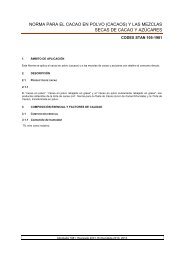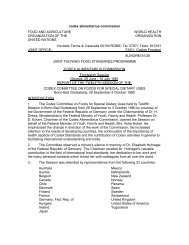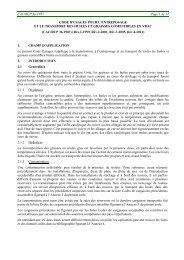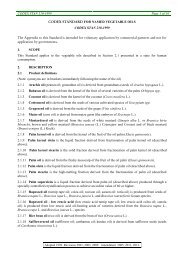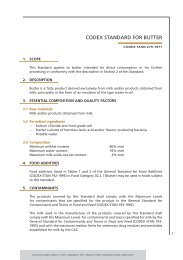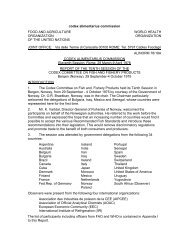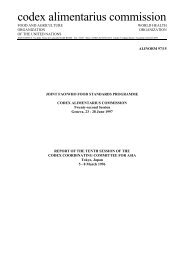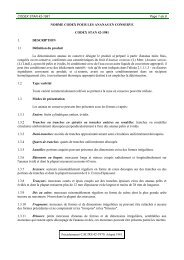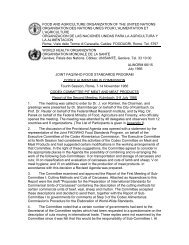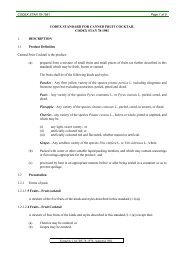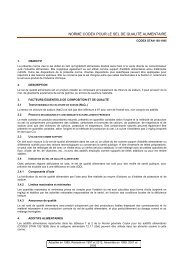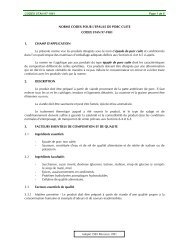REP13/FH JOINT FAO/WHO FOOD STANDARDS PROGRAMME ...
REP13/FH JOINT FAO/WHO FOOD STANDARDS PROGRAMME ...
REP13/FH JOINT FAO/WHO FOOD STANDARDS PROGRAMME ...
You also want an ePaper? Increase the reach of your titles
YUMPU automatically turns print PDFs into web optimized ePapers that Google loves.
<strong>REP13</strong>/<strong>FH</strong> Appendix III 49<br />
further investigation to determine appropriate actions to be taken. Other actions taken may include more<br />
frequent sampling, inspection and audits, fines or official suspension of operations.<br />
4.12 Documentation and Record Keeping<br />
46. Documentation and records are essential to support the microbiological criterion, e.g. documentation<br />
on scientific evidence underpinning the microbiological criterion, records on application/performance of the<br />
microbiological criterion. Records such as test reports should give the information needed for complete<br />
identification of the sample, the sampling plan, the analytical method, the results and, if appropriate, their<br />
interpretation. Reporting against the microbiological criterion may be required by some national<br />
governments. See also Section 5.7 of the General Principles of Food Hygiene (CAC/RCP 1-1969) and<br />
Section 2.3.7 of the General Guidelines on Sampling (CAC/GL 50-2004).<br />
47. Records should be maintained documenting all instances of non-conformance with the microbiological<br />
criterion, together with records of the corrective actions taken, both to manage food safety risks and to<br />
prevent further instances of non-conformance.<br />
5. REVIEW OF MICROBIOLOGICAL CRITERIA FOR <strong>FOOD</strong>S<br />
48. As establishing and implementing microbiological criteria is a part of Microbiological Risk Management<br />
(MRM) activities, refer to the Section 8.2 of the Principles and Guidelines for the Conduct of Microbiological<br />
Risk Management (CAC/GL 63-2007). In addition, revision of microbiological criteria should be considered in<br />
response to revision of other MRM Metrics and also in response to emerging issues or changes in the<br />
following, but not limited to:<br />
Taxonomy, prevalence or distribution for selected microorganisms;<br />
The incidence of disease including attribution to specific foods;<br />
Traits of microorganisms (e.g. anti-microbial resistance, virulence);<br />
The suitability of an indicator organism;<br />
Available analytical methods/tests/appropriateness of test;<br />
Food/ingredients/technology/process of food production;<br />
Food safety control system;<br />
Population(s) at risk;<br />
Consumer behaviour or dietary intake pattern of the food concerned;<br />
Understanding/knowledge of risk;<br />
Trend analysis results; and<br />
Required level of assurance.<br />
49. A review of the microbiological criterion may be initiated and carried out by national governments<br />
and/or food business operators. Codex members may propose review of microbiological criteria in Codex<br />
texts.<br />
50. A review will result in retention, adjustment or revocation of a microbiological criterion, as appropriate.<br />
51. The risk management framework should be used to continuously improve, refine and adjust the<br />
relevant components of the microbiological criterion in relation to their effectiveness, to improved scientific<br />
knowledge and the increasing knowledge of public health risk and related food safety risk management<br />
metrics (FSO, PO and PC). The goal should ultimately be to achieve a more quantifiable estimation of the<br />
linkages between microbiological criteria, other metrics and public health outcomes.<br />
52. When microbiological criteria have been developed to address specific risk outcomes they should be<br />
reviewed against those outcomes and, if shown not to be effective, they should be adjusted or revoked.



